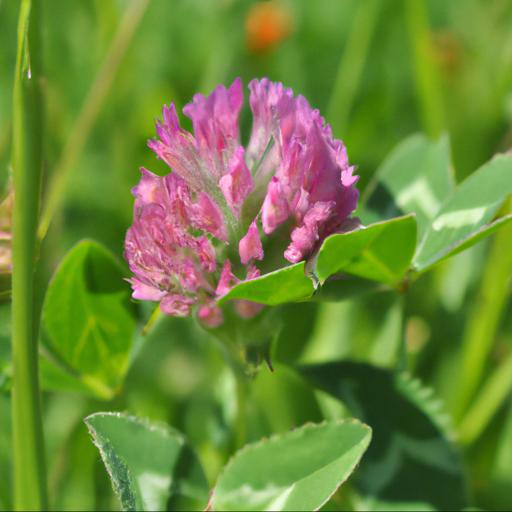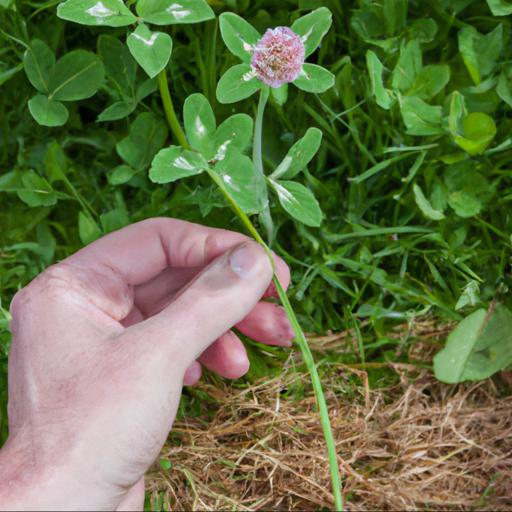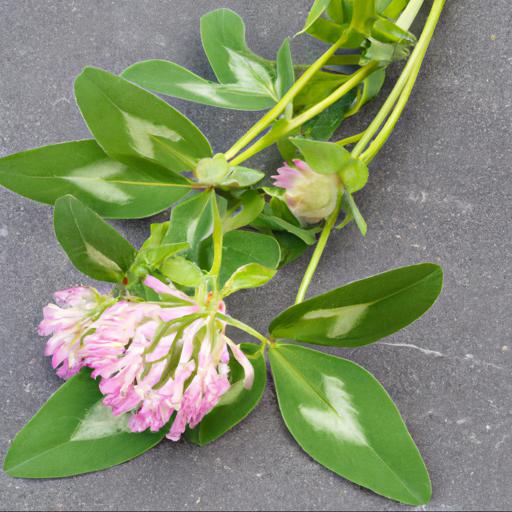Trifolium pratense, also known as red clover, is a flowering plant that has been used for centuries to promote health and well-being. It is a member of the legume family and is native to Europe, Asia, and North America. Red clover contains many beneficial compounds, including isoflavones, flavonoids, and coumarins.
It is known to have antioxidant, anti-inflammatory, and cancer-fighting properties. Additionally, studies have found that red clover can help reduce the risk of heart disease, improve bone health, reduce menopausal symptoms, and more.
Red clover is a safe and natural way to improve overall health and should be considered as part of any healthy lifestyle.
Benefits of trifolium pratense

Trifolium Pratense, commonly known as Red Clover, is a flowering plant that is native to Europe and Asia. It is a well-known member of the Fabaceae family, which contains many other flowering plants ranging from peas and beans to alfalfa and clover. Red clover is a popular choice for both its ornamental value in flowerbeds and its many uses in the garden and to benefit people’s health.
Trifolium Pratense is a valuable addition to any garden. Its rosettes of three broad leaflets make it distinct from other flowering plants, and its pink and white blossoms are a welcome sight in spring and summer.
Not only is it attractive, but its nitrogen-rich foliage helps to replenish the soil, providing a natural source of fertilizer for other plants. It also attracts pollinating insects to the garden, improving the growth of other plants in the vicinity.
While its beauty and garden benefits are undeniable, Trifolium Pratense also has many uses in traditional medicine. Its flowers and leaves contain many phytoestrogens, which make it useful in treating conditions such as menopausal symptoms, high cholesterol, and skin issues. Its isoflavones, saponins, and coumarins also make it a valuable immune system booster and anti-inflammatory agent.
It can even help with digestion, as it helps gut bacteria to better break down food. Trifolium Pratense is a versatile plant that adds beauty and health benefits to any garden. With its distinct rosettes and colorful blossoms, it adds ornamental value to gardens, and its nitrogen-rich foliage can improve the soil and benefit other plants around it.
In addition, its phytoestrogens, isoflavones, saponins, and coumarins make it a valuable medicinal asset, helping to improve gut health and reduce inflammation and cholesterol. No matter what its uses, Trifolium Pratense is a valuable and beneficial addition to any garden.
How to grow trifolium pratense

Trifolium pratense is one of the most popular varieties of clover found in gardens across the United Kingdom. It is a wonderful perennial flower, which offers a fantastic burst of colour to any outdoor space and is incredibly easy to look after. When looking to grow this particular variety of clover, there are certain aspects which need to be considered for the best results.
The first and arguably most important consideration is to determine a suitable location for planting. It is best to plant in an area of the garden that is exposed to partial shade, to avoid the plants being exposed to too much direct sunlight.
Furthermore, your current soil also needs to be taken into consideration as this type of clover grows best in well-drained, nutrient-rich soils. If your soil appears to be overly dry or lacking in nutrients, this should be amended before any planting. Once the prior considerations have been taken into account, the planting process can begin.
It is recommended to plant Trifolium pratense in soil which is located at least 18 inches away from any other plants, in case you need to place support for taller stems later on. In order for the clover to thrive, a distance of approximately 8 inches should be left in between each plant.
Once planted, Trifolium pratense is incredibly easy to maintain. Generally, clover requires little in the way of maintenance as it is a low-growing plant, however, if it begins to show signs of wilting, it is recommended to water the plants a few times a week. Other than that, it should continue to flourish and add a wonderful burst of colour to any garden.
Overall, growing Trifolium pratense is a great option for any UK garden enthusiast looking to add a beautiful and low-maintenance flower to their outdoor space.
Common uses of trifolium pratense

Trifolium pratense, or Red Clover as it is commonly known, is a species of clover endemic to Europe and temperate Asia. This long-lived perennial is an important crop of pastures, meadows and grassy places, and can often be found in flowerbeds or wildflower meadows.
Red Clover is an extremely valuable forage for livestock, providing high quality protein and other nutrients for the dietary needs of grazing animals. It is also widely used for weed control, as it is a highly competitive and fast-growing species that outcompetes many weeds. Red Clover is a valuable garden plant due to its ability to attract beneficial insects.
Its bright, showy flowers make it highly attractive to bees and pollinating insects, helping to ensure pollination of other plants in the garden. Its vigorous growth makes it an ideal companion for plants that require frequent nitrogen fertilizing, as Red Clover is able to fix nitrogen in the soil that is available to the other members of the garden.
Lastly, Red Clover is often used in formulations for herbal remedies. The species is known to contain isoflavones that are known to have many positive medicinal effects, such as reducing cholesterol levels, improving circulation, and reducing the risk of breast and prostate cancer. Red clover is typically used in detoxification teas, capsules, tinctures, powders and liquid extracts.
When taken in small doses Red Clover is generally a safe and effective treatment for a variety of ailments.
Potential side effects of trifolium pratense
As a UK Garden Expert, I am going to explain the potential side effects of using Trifolium pratense, otherwise known as red clover, for gardening and landscaping. Trifolium pratense is known for its beauty and fragrant flowers, making it an attractive choice for many garden and landscape designs. However, it does come with a few potential side effects to be aware of before incorporating it into your garden.
One of the primary potential side effects is that Trifolium pratense can become invasive. This species can easily spread to adjacent areas, taking over and crowding out native species.
If this happens, it can also cause a reduction in biodiversity in the area. This is why it is important to be aware of the growth rate of this species before planting. Another potential side effect of Trifolium pratense is that it can increase the risk of a fungal infection, particularly mildew.
This is due to its ability to become overgrown and overcrowded, making it difficult for air to move and thus creating the perfect environment for mildew to grow. To avoid this issue, keep a watchful eye on the clover, and ensure it is pruned regularly to maintain air flow and healthy growth.
In conclusion, using Trifolium pratense in your garden or landscape has many benefits, but it is important to be aware of the potential side effects before incorporating it into your outdoor space. Remember to keep a close eye on the growth of this plant and make sure to prune regularly to avoid fungal infections.
With a little of care, you can make the most of its beauty without running into any difficulties.
Conclusion
Trifolium pratense, commonly known as red clover, is a species of flowering plant in the legume family. It is native to Europe, Western Asia, and northwest Africa, but has been widely introduced elsewhere. Red clover is a valuable forage crop and is used for hay, pasture, and soil improvement.
It is also used as an herbal medicine to treat a variety of conditions, including menopausal symptoms, respiratory problems, and skin disorders. Red clover is a nutritious source of protein, vitamins, and minerals and is a valuable addition to any diet.
FAQ
What are the common names for Trifolium pratense?
Common names for Trifolium pratense include red clover, meadow clover, purple clover, and cow clover.
What are the medicinal uses of Trifolium pratense?
Trifolium pratense, commonly known as red clover, has a variety of medicinal uses. It is used to treat respiratory conditions such as asthma, bronchitis, and whooping cough, as well as skin conditions such as eczema and psoriasis. It is also used to reduce inflammation, improve circulation, and boost the immune system. Additionally, red clover is used to treat menopausal symptoms, reduce cholesterol levels, and improve bone health.
What are the nutritional benefits of Trifolium pratense?
Trifolium pratense, also known as red clover, is a nutrient-dense plant that is rich in vitamins, minerals, and antioxidants. It is a good source of calcium, magnesium, potassium, and vitamin C, as well as B vitamins, iron, and zinc. Red clover also contains isoflavones, which may help reduce the risk of certain cancers and improve menopausal symptoms. Additionally, red clover is a source of dietary fiber, which can help promote digestive health.
How is Trifolium pratense used in traditional medicine?
Trifolium pratense, commonly known as red clover, has been used in traditional medicine for centuries to treat a variety of ailments, including respiratory and skin conditions, as well as to promote general health and wellbeing. It is also believed to have anti-inflammatory, anti-cancer, and anti-oxidant properties.
What are the environmental benefits of Trifolium pratense?
Trifolium pratense, commonly known as red clover, has many environmental benefits. It is a nitrogen-fixing legume, meaning it helps to improve soil fertility by adding nitrogen to the soil. It also provides a food source for pollinators, such as bees, and can help to reduce soil erosion. Additionally, it can help to reduce the need for chemical fertilizers, as it naturally adds nitrogen to the soil.
What are the potential side effects of consuming Trifolium pratense?
The potential side effects of consuming Trifolium pratense include nausea, vomiting, diarrhea, abdominal pain, headache, dizziness, and allergic reactions.

